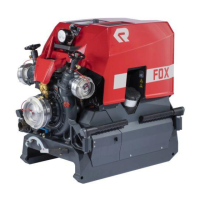Servicing and cleaning
72 / 97
Inspection procedures
8.5 Inspection procedures
Testing and inspection procedures
Assessment and inspection work may only be carried out by correspond-
ingly trained fire-fighting personnel, who are familiar with the portable fire
pump.
The work must be carried out regularly, especially after each use, to ensure
optimum operational safety of the portable fire pump.
All components, locks and fittings of holding and storage systems have to
be checked if they are in a good condition and verify safe storage. Any de-
viation, damage or defects must be corrected immediately or repaired.
Observe the operating instructions of the individual pieces of equipment
and units!
Portable fire pump
► Check the entire portable fire pump for damage or other defects.
► If damage to the lining parts in the area of the filler neck (tank fill-
ing lighting TB1, fuel tank cap 29) is present, further operation or
start-up is prohibited.
► Put the portable fire pump into operation and check for proper function-
ing.
► Check the operation and status of all valves, instruments and gauges.
► Check the cleanliness of the suction filter in the suction hose.
► Check cleanliness of the strainers in the supply line.
V-belt for priming pump drive
Check V-belt carefully for signs of mechanical damage at least once a year.
Avoid contact between V-belt and all lubricants.
Reduced performance or failure of the transmission because of oil on the
V-belt.
With oil contaminated V-belts or V-belt pulleys can not transmit the required
driving force and slip through.
Avoid oil pollution of the V-belts and V-belt pulleys.
Clean with oil contaminated V-belts and V-belt pulleys.

